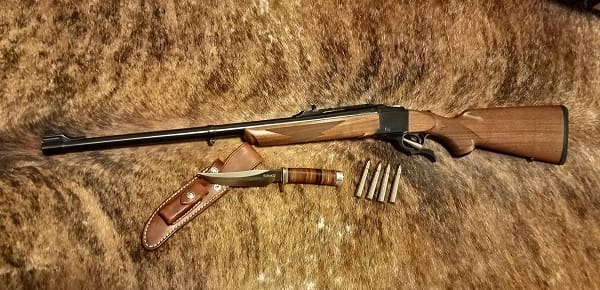
I had a pretty awesome childhood. As young as eight years old, it consisted of days, and often weeks completely on my own, wandering thousands of acres of Texas hill country land and creeks. During the day, I ran, climbed, swam, fished and hunted as I desired. My nights were filled reading about war in books and hunting in magazines, and the National Geographics I got from my uncle Frank.
To many people, that may sound lonely. But I wasn’t alone. I had my own dog and my own gun. For a young boy, it was heaven on Earth.
The dog was Max, a 90 lb pit bull/black lab mix who could be uncontrollably vicious to anyone who threatened me, and at the same time, unfailingly patient and loving. I was told more than once that I smelled like Max. That was a matter of pride for both of us.
The gun was, at first, was a Savage Model 24 in .410/.22 Magnum. Later it was a single shot with interchangeable 20 gauge and .30-30 barrels. Eventually, as will all things, a great dog died, a boy grew up, and I moved away. But I still have those guns, and I still hunt with them.
Thirty years after I took my first white tail deer with a slug from that Model 24, my son did the same, holding that same rifle. We dove hunt with the 20 gauge all season. All these years later, I have many guns of many different action types and calibers.
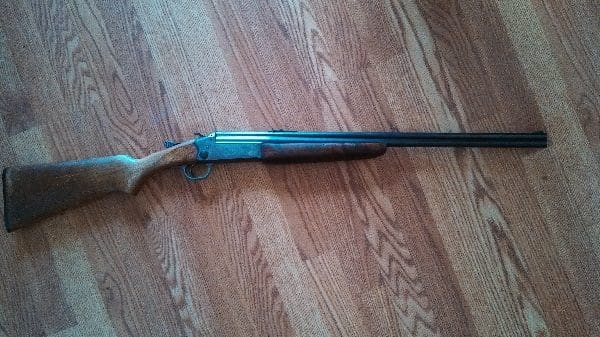
But I don’t have the gun. I don’t have the gun that I as a boy dreamed I would have as a man, walking the “long grass” of Africa searching for the Black Death, wading the cold streams on thawing islands, on lookout for Kodiak Bears, or in British Coloumbia, in the thick of the trees, hunting moose. I didn’t have the gun I dreamed of traveling the world with, the gun capable to taking anything on Earth.
Oddly enough, I ended up traveling the world, but it was with different guns, the M16 and M4. And my prey, although certainly no less threatening than the Cape Buffalo, was a different animal altogether.
Like that great dog and my childhood, that time has passed as well. I’m finally at the point in my life where I am travelling, not on orders, but still on a mission. That mission is often a hunt, and I’ve finally been able to book some of those adventures I’ve dreamed of for the last 40 years.
Ah, but the rifle. I still didn’t have the rifle. The last rifle I’d ever need to own. The last rifle, capable of hunting any animal on Earth. This year, though, I decided to get it.
As you might imagine, I had some decisions to make. Caliber, however, wasn’t one of them. The rifle would be chambered in .375 Holland and Holland Magnum. Not the largest of the big game cartridges, but the smallest capable of legally and ethically taking the Big 5.
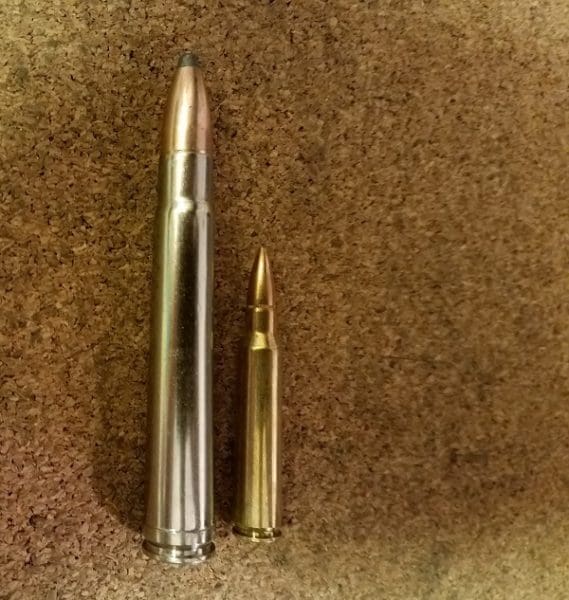
The .375 H&H is just over 100 years old and remains one of the most versatile calibers made. It can be loaded with a 350 grain bullet to velocities over 2,200 fps to reliably kill any animal on the planet. With a well constructed bullet, penetration is exceptional.
It can also be downloaded way down to launch a 225 grain round at 2,000 fps for target practice or hunting deer, antelope, and the smaller black bears in North America. And there’s a variety of rounds and recipes in between. I’ve asked many African game guides what caliber they would choose if they could have only one, and .375 H&H won by a landslide.
Also not up for discussion, the rifle will feature wood. Fine wood. I understand that synthetic stocks are more durable, theoretically. I say theoretically because I’ve several guns over 100 years old, and one that’s 200 years old, all with working, solid, wooden stocks. A high quality, wooden stock isn’t just beautiful, it’s proven in a way no other material can possibly say it has been. So wood. That’s settled.
What hasn’t been settled is the action. My first thought was a full stocked bolt action rifle in a Mauser-type action. That would be the obvious choice. But the obvious choice isn’t what I dreamed of owning. The stories I read as a child were usually of double rifles, or single shot English sporting rifles. Walking around with my own single shot rifle and shotguns, this made perfect sense. One animal, one shot, careful and sure. As a child, I thought this was how real hunters did it. How could it be any other way?
So then the last bit was settled. A Ruger No. 1, which has always been one of my favorites. Relatively inexpensive, the No. 1 is one of the strongest, if not the strongest, action types available for modern sporting usage. The rifles are chambered in many calibers, I’ve seen them in everything from .243 Winchester all the way up to the punishing .378 Weatherby Magnum.
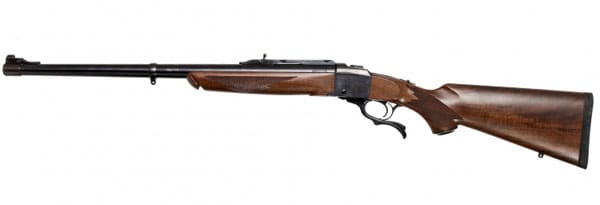
They come in a variety of stock styles and barrel options. For me, none of those things mattered but the action type. After looking online, I happened to see one at my local Cabella’s, a new Ruger No. 1 Tropical chambered in .375 H&H. I bought the rifle and 20 rounds of quality ammunition for just under $800. It was an easy sell.
The reason that the barrel and stock option aren’t important to me is that I’ll be scrapping both. I also intend to improve the good, but not great trigger, as well as change the sights a bit.
Before I got to changing things, I wanted to see what the stock rifle will do. This one has a 24-inch medium heavy barrel. One of the great things about the No. 1 is that, because of the extremely short action, a 24-inch barrel handles like a 20-inch barrel on a similarly chambered bolt gun.
I found it to be a very handy rifle, easy to shoot off-hand and from the kneel. It’s not terribly comfortable at the bench or from a rest, and I looked to change that as well. With an Atibal Nomad scope turned all the way up, mounted in the supplied rings, my average group for four groups of five shots equaled 1 3/4″ at 100 yards. I’d like to see better, but actually, for my purposes, that’ll do.
Recoil is stout, especially from the bench, but not altogether punishing. A 20-round string leaves me a bit sore, but unbruised. Of course, there were no problems with feeding or extraction at all. The action is smooth and worked perfectly.
Although I’m an amateur wood worker and gunsmith, this is a job for a professional. I met that professional last year at the Team 5 Medical Foundation’s SHOT Show fundraiser. John Stewart of Kiote Rifles had one of his precision .308s there, and the quality and workmanship of that rifle was absolutely exceptional.
After talking with Mr. Stewart, I was convinced I wanted one of his rifles. I just didn’t know which one. When he told me he was looking for something new and interesting to work on, I had just the thing in mind. The No. 1, but redone.
Mr. Stewart wasn’t the first quality gunsmith I asked about the project. Everyone else either told me no, or did not instill confidence. These were all good smiths, but they did what they did, and only what they did and none of them specialized in the No. 1.
Mr. Stewart’s attitude was refreshing. He wanted to do what he hadn’t done, but with the same (sometimes maddening) attention to detail and quality that he had focused on with his precision bolt guns. He agreed to take on the project.
Over the course of the next couple of weeks, we walked through dozens of details and questions, many of which I just had to leave up to him. He took the project in directions I wouldn’t have gone, but I was glad he did. After hearing that I wanted to shoot it both iron sighted and with a low power optic, he suggested a hidden adjustable riser inside a modified wooden stock. I was wary. He sent me a sketch.
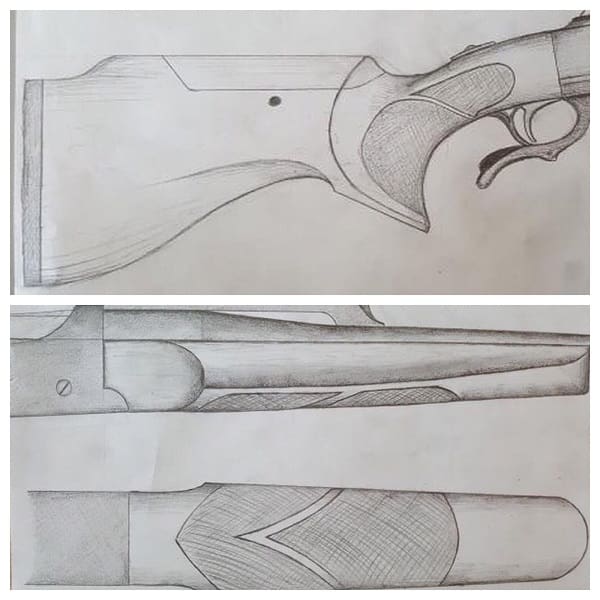
I was sold.

The stock would be made by Armstrong Precision Gunworks out of the great frozen north of Canada. They sent some photos and I picked out a gorgeous piece of black walnut with practically holographic grain.
I’ve seen hidden risers on some of his bolt gun stocks, and hidden is the right word. Not only would the No. 1 have an adjustable comb, but the shape of the stock and fore-end would be like no other No. 1 made. A little nicer shooting from a rest, its shape would also manage recoil better, and add some weight to the gun. Weight on a belted magnum is good.
Mr. Stewart is going to try to improve the gun’s accuracy with a custom 26-inch Pac-Nor barrel. I’d really love an octagonal to round barrel, but so far neither I nor Mr. Stewart have been able to find any high quality manufacturer who will cut that profile. If anyone out there has any leads, I’d appreciate it.
There’s going to be quite a bit of work for Mr. Stewart after the barrel is cut, because both sights and the scope mounting rib are on the barrel itself. Mr. Stewart will also be in charge of bringing that trigger down to to 2.5 lbs and polishing it up to break crisp and clean.
Last, but certainly not least, Mr. Stewart will send the rifle off to have all the metal master-blued and polished. At some point, we’ll change the front sight a bit as well, and I haven’t decided on what glass to mount on it yet.
All in all, it will be a very different Ruger No. 1 than we started with, and hopefully, a much better one. The goal is a beautiful, robust, one-of-a-kind rifle that will be comfortable to carry and shoot, weight around 10 lbs, and hopefully be a little more accurate.
I expect the project will take some time, but hope to have it ready to hunt with some time this winter. I’ll be filing you in on its progress, as well as its future hunts. If it ends up as we all hope, I expect this to be the last rifle I buy for a long time, and certainly the last rifle I’ll ever need. Well, we’ll see about that.

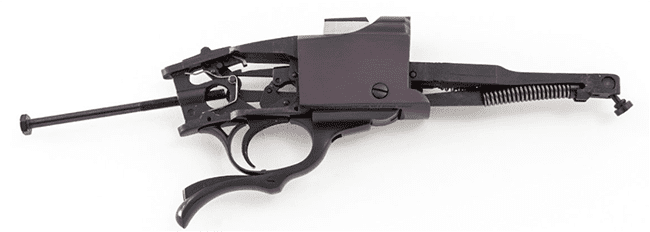



Neat project! The only 375 H&H I’ve shot was a No. 1, and as you remarked, it was so handy and wieldy I couldn’t believe the 24″ barrel length. The same range day, I shot a CZ Mauser in 416 Rigby – distinctly less of a sharp recoil and more of the shotgun feel. Made the 375 feel like a sports car. Looking forward to the next story!
Estimated cost?
I estimate it will cost a lot. I’ll let you know real costs as they are done.
; ) Would like to hear.
$800 plus alterations.
I’m assuming that was a used ri fle at that price.
No sir. Brand new.
I wouldn’t be able to get my wallet out fast enough. I’ve been looking around online and almost never see them (.375H&H, new) under $1200. I figured Cabelas would be asking $1300+. I picked up a .303 last year for under $900 but it was off a collector – unfired but it was made in 2010. That was about the best deal I’d seen in any calib er. Good deal.
I am very interested in the finished product. This is shaping up to be an excellent rifle.
I personally have an aversion to the Ruger #1. The ones I’ve owned have been particularly punishing when compared to any other action in the same caliber. I do not understand why. If this “tames the beast” I’d really like to know.
Heavy wood and more of it, as well as 2″ more of barrel will heavy up the gun, certainly reducing recoil. That’s where I’ve seen the additional felt recoil of No. 1s come from, they are typically a pound or more lighter than bolt guns of the same caliber and barrel length.
Limited experience, but you can hardly tell the difference between my .303 no.1 and my .308 Rem. 700 at first, but the recoil fatigue sets in much later in the no.1.
I like the idea of falling or rolling blocks, but I read that those have incurable mediocre accuracy.
“What do you need it for?” You might ask. It’s not a matter of need, it’s a more-is-more thing; I send a bullet my intention is to have it to go to a point not just somewhere in the vicinity. And it shouldn’t be too much to ask from a simple, mature design that costs a thou or so.
Getting the metal to wood, especially the fore-stock, to fit right and not bounce on the barrel is a particular challenge. When that is done right, I’ve seen No. 1s at MOA, or just barely under. I’d be satisfied with it as is, happy with 1.5, and thrilled to see a .375HH single shot at 1MOA.
I don’t think there’s any inherent accuracy problem with a falling block action. From what I’ve been told, the No 1 suffers mainly from Ruger’s barrels.
The modern 1885 reproductions from Winchester and Browning are reputed to shoot sub minute of angle from the factory.
S,R&Co’s consistency when it came to accuracy used to be a bit hit or miss (and not just with the no.1) but those older g uns tended to have spectacular wood (frequently as good as JWT’s blank). Now the walnut is usually fairly plain but the accuracy is much more consistent. Generally though, great walnut is much harder to come by these days and great accuracy is much easier.
Ok, well, GL. I think the concept has potential, shorter action, rate of fire depending on the use maybe not worse or even better, no open bolt wobble (yuck), I think I’d find the manipulations more natural. I think with up to date design they could be as accurate as anything. I’d like one of those EABCO’s but they’re rare, expensive and allegedly don’t extract too spunkily.
For the barrel did you guy’s contact Lilja Barrel’s? http://riflebarrels.com/ They do octagonal barrels http://riflebarrels.com/octagon-2/.
I was gazing at the C. Sharps company 1885 falling blocks last night, and I know they turn out octagonal to round barrels for their riflew=s, plus they do pure custom wor, though I have no idea if they’d do something like this. I take it Stillen is out.
I love what you’re doing. I love the action type and would love to see what you can do with it. I keep hearing that if you want superb acuracy you have to go bolt gun, which is disappointing, but you can’t have everything I guess.
Really really looking forward to hearing more on this.
Congrats! Having dreams come true rocks.
” I expect this to be the last rifle I buy for a long time, and certainly the last rifle I’ll ever need. Well, we’ll see about that.”
A common meme in the boating world is a variation on a boat name of “My last boat # 8”.
That wood is drop-dead gorgeous.
May many game drop dead because of it…
Nice post.
I hope you YOUR rifle. It is that now because it will be modified for you.
I really enjoyed the memories of the guns of childhood.
Nothing else is as relaxing to me as hitting the squirrel woods with a single shot shotgun.
My dog Private (terrier and feist) is long dead so I’m on my own for spotting squirrels.
Hunting at its best. Sometimes, I actually bring home some squirrels.
I’ve got a no.1 in .303 and love it. One in .375H&H is on my short list, although I don’t have any plans to go on safari. I mostly think that’s probably the outer limit of my recoil tolerance.
Really looking forward to the follow ups. That is stunning wood.
Last rifle?
HAHAHAHAHAHAHAHAHAHAHAHAHAHA
snort
HAHAHAHAHAHAHAHAHAHAHAHAHAHA
+1. Guffaw.
It may be the last rifle you need, but it’s unlikely to be the last rifle you want. Damn, but that is a fine, fine project. Good luck!
Do you have a larger pic of that stock blank? I’d like to use it as a desktop background so I can stare at that wood grain all day.
Dude. You’re getting wood for wood.
Also. Moist nugget. 🙂
That is some purty walnut. Well chosen.
I bought a #1 in .270 Win in the mid ’70’s . It was my year round go to rifle until it was stolen about 15 years later . It never let me down .
Mel Forbes rechambered at least 2 .458 Win #1’s to .460 Wby during that time period that were excellent shooters when tried at my farm .
This appears to be a fantastic, noteworthy endeavor. It’s nice to see some love for an old classic cartridge instead of yet another ultra short magnum.
I’m also a member of that used to be common, but is now rare, club. I grew up roaming the plains of NE Montana in the Sixties. I lived in the saddle and carried a Ruger Bearcat from the age of ten.
It’s a great way to be alive, isn’t it?
I hope you and your rifle have many beautiful children together.
“But I wasn’t alone. I had my own dog and my own gun.”
Murica 🙂
Hope this project go well and may you get many years of enjoyment out of this rifle.
Consider having the safety button recessed into the top tang, it really transforms the look of things over the factory configuration.
Just curious, but why is every attempt I make at making a comment on this article going into moderator limbo?
I found a Sako in .375 with a stutzen (Mannlicher style) stock a while back. Had I shot right handed I would have brought it home. Very well balanced.
I ran across a used but nice #1 just as described in the article, .375 of course, late last week. Maybe I’ll have to head back for a second look. I’ve been keeping my eye out for a .45/70 one.
The Ruger No 1 is a beautiful gun, and the. 375 H&H is a great round. I’d like a .375 as well, but I’d be more inclined to go with a Sako 85. I gotta say that I’m definitely interested in the end result, and I give you props if you chase any of the Big 5 with a single shot.
Unfortunately, that won’t buy me any bragging rights. My business partner took 200 African game animals, including both a lion and a truly massive cape buffalo, all with a pistol, and most of those a single shot pistol. He took the Cape within about 15 yards. All on video. I’m not likely to match that in my lifetime.
He was in a tree when he shot that Black Death from 15 yards with a single-shot pistol, right?
I’ve seen video of a (white) guy using a SPEAR on a Buff. Don’t recall if it was Australia or Africa. Anyway, if you can think of it someone has probably already tried it.
I’d require a gonad transplant before I even tried.
That guy should write for TTAG! I wouldn’t consider myself risk-averse, but I have a penchant for as much firepower as I can carry.
Great article, I am looking forward to seeing/hearing more about it. Also not all African countries require .375 or larger rounds, just most.
Triple thumbs up pal Great project that’s going to make a great heirloom !
Nice project and should be a great rifle. Had a No 1 458 Win mag it was ok but more recoil than I liked. Swapped for 1 in 375 H&H true love ! Then got bit by the 50 cal bug. The 50 is a soft shooter but hard to find a place to shoot. Evan on my own property having a safe and sure backstop can be difficult. So I’m going to go back to a No1 in 375.
Great article and a true labor of love. It’s disappointing that so few people really understand the mystique and sheer magnetism of a genuinely well engineered rifle. They are true works of art and you, Sir, have captured that spirit in your project. Godspeed to you and I look forward to someday seeing an article regaling us with a description and pictures of the finished product, followed closely by a stirring tale of your first foray into the wilds with it.
Good article! I love single shots too. I own a 338 LM and a 284 both are single shots, and shot the barrel out of a single shot 300 WSM. I’ve thought seriously about getting a Ruger #1. Thing is I don’t even hunt. I just target shoot so caliber choice is always a decision based on accuracy and whether the rifle shoots good at long range. I’m getting old, but your story makes me want to get one more. I really like the lengths you’re going to with this project. It should be a wonderful rifle.
For me, nothing beats a blued rifle with a nice walnut stock. I’ve only owned one Ruger #1, and it was a beautiful rifle. The only reason I sold it was that it had terrible accuracy (22 Hornet).
The one thing I don’t understand is why anyone would want to hunt dangerous game with a single shot rifle?? Of course if you have several other fellows with you all armed to the teeth, for a back up, then I can understand it. But then what are you going to tell folks back home when they are admiring the head you had mounted, hanging on the wall, “I got the first shot in”
I suppose some of you are going to tell me that you are a good enough shot that you will never miss, Ha!
Try cutting flats (for the octagon) into a #4 contour barrel with a hand file. I ran this same road several years ago on a .25-06 I was building and also discovered the difficulty in obtaining a decent half round/half octagon bbl. If you work slowly, you can keep the flats the same width and it really looks sharp to feather them out into the round part of the bbl.
Hey mate nice story.
Let me tell you, once you go up in caliber there’s no coming back! It really ruins the novelty of hunting with smaller calbers and it’s never the same again.
I own a .375 H&H mag and it’s great fun to shoot, there’s something reassuring about no longer having to worry about dinosaurs when your out in the back woods by yourself.
Now i’m thinking hmmmmm, wouldn’t it be awesome to go even BIGGER?
Lately I’ve been eyeing off one of those a Sako 85’s in .450 Rigby
Gear up as your favorite Delsin Rowe Vest. Slim Fit Leather Jackets brings this iconic jacket from animation to reality, especially for all the fans of this video game. Delsin Rowe is the main protagonist and playable character, a young Native-American man who later realizes he’s a Conduit with special powers.
Comments are closed.